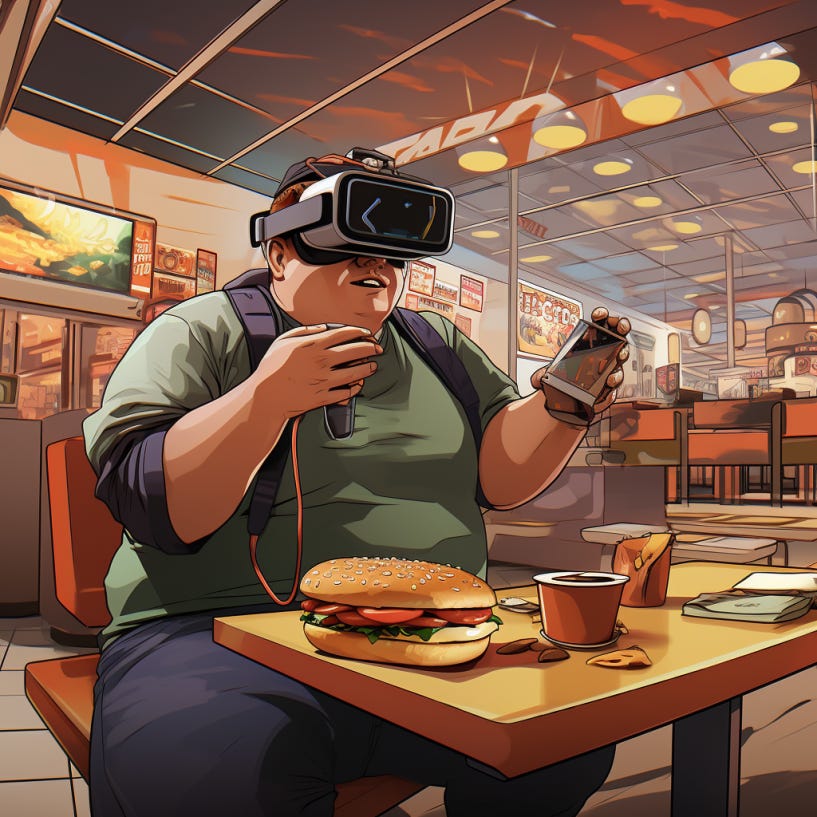- Published on
Living in WALL-E World
Welcome to the Ubik Blog!!
If you haven’t already subscribed, subscribe here!
Here’s some important stuff you should check out :)
MTA tests out new harder-to-jump subway turnstiles
A new federal report finds that climate change harms daily life across the US.
Check out our AIED tools here:
Living in WALL-E World
Exploring the social drawbacks of virtual experiences
"WALL-E," the 2008 Disney film, depicts an apocalyptic world where humans are constantly entertained but socially devoid. Overweight bodies with screens for eyes, bound to futuristic mobility scooters, how far are we from WALL-E's world?
I'm on the train, and no one is looking up.
For Generation Z, virtual spaces have always felt like a second home. Nevertheless, after over a decade of "smart" tech and social media, it is impossible to talk about the benefits without stating the obvious: we are addicted to screens. The wake-up scroll, the bathroom scroll, the train scroll, the procrastination scroll, the bedtime scroll, repeat.
Screen time and children
Digital media consumption has become a core part of childhood in our tech-centric world. With access to computers, tablets, and phones, the influence of screens on child development is a real worry felt by parents and educators worldwide.
Screen time closely relates to mental well-being, notably in teenagers, where increased screen time is associated with a higher risk of anxiety and depression symptoms. Similarly, there are direct connections between the prevalence of edited photos and unrealistic online body standards and the rise in body dysmorphia and dissatisfaction.
With poor guidance on responsibly using screens, younger ages often develop "problematic internet use," a term to describe impaired cognitive development in areas like attention, memory, and decision-making via high screen time (Wilkinson et al., 2021).
Virtual Reality vs. Augmented Reality
Virtual Reality is a complete, immersive virtual experience where users interact with digital objects and spaces as if in the real world. Augmented Reality differs from this by "augmenting" the real world, so users are still experiencing their physical space but with virtual add-ons like screens or games that interact with physical objects.
Exploring VR/AR Headsets
Gamers make up a large portion of VR users. However, immersive gameplay experiences are just one of the reasons people are starting to shift to VR/AR technologies. Now, users can design custom screens to watch movies from their couch as if in the cinema. Why pay to see the film on the big screen when I can sit at home?
With new advancements in Virtual and Augmented Reality (VR/AR) and new Work from Home (WFH) or Zoom School standards, it is clear that this technology is here to stay. Products like the "Meta Quest 2" by Meta offer an interactive WFH experience so employees can maximize efficiency in settings that may not be conducive to work.
While WFH offers convenience, it also means trading off employee social interaction for lower operational costs and increased convenience. What's Lost in Virtual Experiences (VE)?
What Does One Lose in Virtual Experiences (VE)?
Screen time has diverse physiological and psychological effects on children and adolescents (Twenge & Campbell, 2018). Generation Alpha has grown up with personal screens as a defining aspect of their lives. For many kids, screens serve as a tranquil escape from overstimulation. This sudden calmness mirrors the initial relief a drug addict feels from a dose.
Twenge and Campbell (2018) explored screen time's diverse physiological and psychological effects on children and adolescents. They found a direct association between increased screen time and mental health: notably worse sleep, cardiovascular health, orthopedic health, mental health, ADHD, and social outcomes. Essentially, the entire body. The CDC (2018) says that in one day, "kids ages 8-18 now spend, on average, a whopping 7.5 hours in front of a screen" (Centers for Disease Control and Prevention, 2018). If kids spend 8 hours sleeping, that leaves 16 waking hours. So, if children spend 7.5 hours on a screen, nearly 50 percent is spent sitting, relaxing, and being sedentary.
Researchers are worried about this sedentary lifestyle and its effects on children. Lui, Szeto, and Jones (2011) state that electronic gaming has contributed to a rise in obesity, addiction, and musculoskeletal disorders. Gaming remains a central reason to purchase a VR headset. With stacking evidence about screen time affecting children's health, it is a logical next step that VR headsets will increase these already prevalent problems.
Loading...
Responsible VR/AR Development
The shift towards prioritizing virtual socialization through responsible VR/AR development holds immense potential, especially in educational settings. For instance, employing virtual environments in subjects like biology transforms the learning experience, offering immersion that transcends traditional classroom limitations. This approach not only captivates students but also significantly boosts their learning engagement. Effective learning methods, particularly those that are interactive, are crucial for enhancing information retention.
Conversely, traditional lecture-based methods, characterized by one-way communication, often lag in engagement and effectiveness. In comparison, 'learning by doing'—whether it involves conducting interactive science experiments or using tactile aids like counting blocks for younger children—makes education enjoyable and memorable. This hands-on approach makes learning more engaging and substantially improves the retention of information, thus shaping a more effective and enjoyable educational experience.
Fiig.ai by Ubik
Fiig.ai from Ubik Studio is an academic tool that helps humans collaborate with AI to understand research without sacrificing learning. At Ubik, our mission is to create products at the intersection of technology and positive impact.
Join us
After making an account at fiig.ai, users can:
SEARCH peer-reviewed journals
Get help using AI studies findings to PLAN projects
COLLABORATE with AI to finalize reports (with citations)
Subscribe
Work Cited
Centers for Disease Control and Prevention. (2018, January 29). Infographics - Screen time vs. lean time. https://www.cdc.gov/nccdphp/dnpao/multimedia/infographics/getmoving.html
Lui, D. P. Y., Szeto, G. P. Y., & Jones, A. Y. M. (2011). The pattern of electronic game use and related bodily discomfort in Hong Kong primary school children. Computers & Education, 57(2), 1665-1674. https://doi.org/10.1016/j.compedu.2011.03.008
Twenge, J. M., & Campbell, W. K. (2018). Diverse physiological and psychological effects of screen time on children and adolescents: Literature review and case study. Environmental Research, 164 , 149-157. https://doi.org/10.1016/j.envres.2018.01.015
Wilkinson, C., Low, F., & Gluckman, P. (2021). Screen time: The effects on children's emotional, social, and cognitive development.

